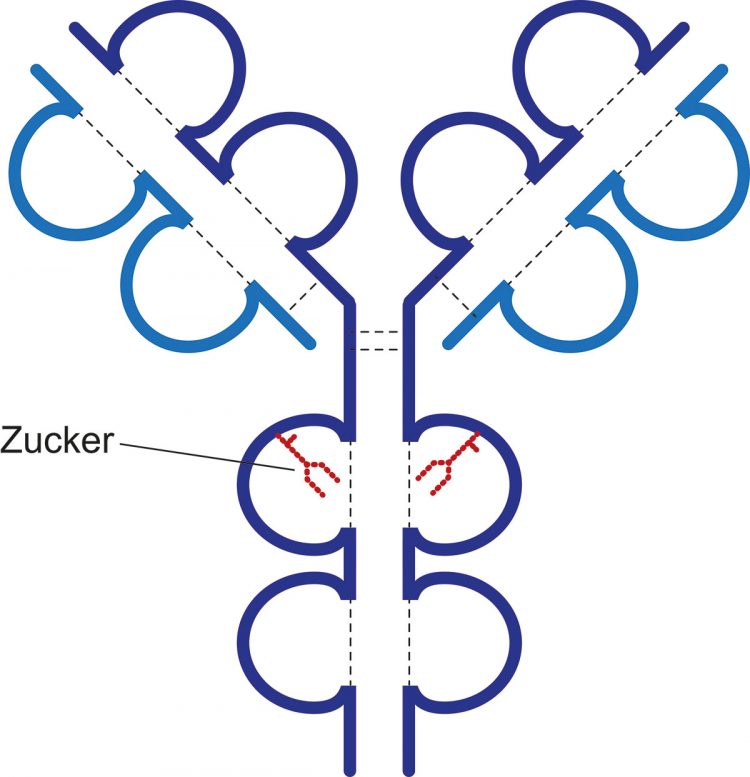Sugar governs how antibodies work in the immune system

Antikörper sind Y-förmig gebaute Moleküle. Zuckerstrukturen (rot), die an das Antikörperprotein gekoppelt sind, spielen eine wichtige Rolle für die Funktion von Antikörpern. Das Vorhandensein von Sialinsäure an dem Zucker führt dazu, dass Antikörper weniger stark ihre Zielzellen angreifen und zerstören. (Bild: UZH)
The immune system is our biological defense shield. Antibodies protect the organism against invading pathogens such as viruses or bacteria. In the case of certain autoimmune diseases, however, this defense behavior is misdirected: The antibodies don’t just target foreign substances; they also attack the body’s own cells. Once the antibody binds to the cell surface, they can activate specific proteins, so-called complement factors, which can damage the cell membrane and thus kill the cell.
Sialic acid protects from antibody-induced cell killing
A team of researchers headed by Professor Jan Lünemann from the Institute of Experimental Immunology at the University of Zurich has now discovered that a particular sugar structure in the antibody plays a key role in the complement-dependent destruction of the body’s own tissue. Antibodies consist of protein and coupled sugar groups. Earlier studies revealed that antibodies with the sugar structure sialic acid are detectable more rarely in patients suffering from autoimmune diseases than in healthy people.
“We observed that patients suffering from an autoimmune disease felt better the more sialic-acid-carrying antibodies they had in their blood,” reports Isaak Quast, a doctoral student in Lünemann’s group and the study’s first author. Different versions of antibody-coupled sugar structures were produced in the lab. “We managed to demonstrate that antibodies containing the sugar sialic acid only destroy the body’s own cells to a very limited extent. Our data indicates that the coupling of sialic acid to antibodies might be a potential strategy in treating patients with autoimmune diseases,” summarizes Lünemann.
Literature:
Isaak Quast et al.. Sialylation of lgG Fc domain impairs complement-dependent cytotoxicity. The Journal of Clinical Investigation, 2015, October 5. DOI: 10.1172/JCI82695.
http://www.mediadesk.uzh.ch/articles/2015/ein-zucker-bestimmt-wie-antikoerper-im…
Media Contact
All latest news from the category: Life Sciences and Chemistry
Articles and reports from the Life Sciences and chemistry area deal with applied and basic research into modern biology, chemistry and human medicine.
Valuable information can be found on a range of life sciences fields including bacteriology, biochemistry, bionics, bioinformatics, biophysics, biotechnology, genetics, geobotany, human biology, marine biology, microbiology, molecular biology, cellular biology, zoology, bioinorganic chemistry, microchemistry and environmental chemistry.
Newest articles

A universal framework for spatial biology
SpatialData is a freely accessible tool to unify and integrate data from different omics technologies accounting for spatial information, which can provide holistic insights into health and disease. Biological processes…

How complex biological processes arise
A $20 million grant from the U.S. National Science Foundation (NSF) will support the establishment and operation of the National Synthesis Center for Emergence in the Molecular and Cellular Sciences (NCEMS) at…

Airborne single-photon lidar system achieves high-resolution 3D imaging
Compact, low-power system opens doors for photon-efficient drone and satellite-based environmental monitoring and mapping. Researchers have developed a compact and lightweight single-photon airborne lidar system that can acquire high-resolution 3D…





















